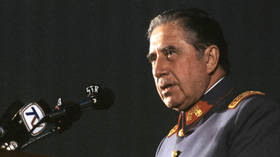Papers reveal US-backed Brazil’s role in installing and supporting Pinochet in Chile

Washington’s involvement in the violent overthrow of the democratically elected government of Chile in September 1973 is by this point well known. The pivotal role played by Brazil has not been as clear until now.
On the anniversary of the 1964 US-backed coup that led to Brazilian President Joao Goulart being replaced by a military junta, the National Security Archive has published a trove of previously classified documents showing the role that junta later played in subverting democracy in Chile, and its subsequent support of General Augusto Pinochet’s brutal repression of political opponents.
The file trail begins September 22, 1970, 18 days after Salvador Allende of the Popular Unity alliance narrowly won the Chilean presidency. A document, prepared for General Emilio Garrastazu Medici – then the third president of Brazil’s military dictatorship – summarizes a recent meeting between the US ambassador to Chile, Edward Korry, and his Brazilian counterpart.
Following Allende’s victory, Korry, a veteran diplomat during the administrations of Presidents Kennedy, Johnson, and Nixon, vowed that “not a nut or bolt shall reach Chile” under the socialist’s rule, and if and when he took office in November that year, the US would “do all within our power to condemn Chile and the Chileans to utmost deprivation and poverty.”
Accordingly, the summary makes clear US plans to undermine Allende were well underway by the time the two ambassadors met.
“Following direct orders from the White House,” Korry was said to be “insinuating to all relevant sectors” that Chile would have “difficulties” – including a shortage of foreign credit and military aid – should the country’s Congress confirm Allende as leader. He also noted the US Embassy was distributing written material warning of the dangers of an Allende government to Chilean military commanders, the very elements that would brutally take power three years later.
Korry’s message was clearly received loud and clear, for in March the next year – five months after Allende’s confirmation – Chilean ambassador to Brasilia Raul Rettig submitted a troubling report to his foreign ministry, titled ‘Brazilian Army possibly conducting studies on guerrillas being introduced into Chile’.
Rettig – who, two decades later, chaired the country’s first ‘truth commission’, which investigated human rights abuses during Pinochet’s rule – had heard from multiple sources that the Brazilian regime was extensively evaluating how to instigate violent insurrection in Chile and overthrow the Allende government via an “armed movement.”
Plans were well developed already, with the military having established a dedicated ‘war room’, with maps and models of the Andean mountain range along the Chilean border, to plan infiltration operations. A number of Brazilian secret agents had also reportedly “entered the country as tourists, with the intention of gathering more background on possible regions where a guerrilla movement might operate,” Rettig’s report revealed.
Brasilia was highly confident of success. In a November 1971 meeting at the White House, President Medici assured Richard Nixon that Allende “would be overthrown for very much the same reasons that Goulart had been,” and Chile’s military was up to the task. He added that Brazil had been “exchanging many officers with the Chileans, and made clear that Brazil was working towards this end.”
In return, the US president pledged “to be helpful in this area,” such as providing “discreet aid,” on the basis that “we must try and prevent new Allendes and Castros and try, where possible, to reverse these trends.” A contemporary CIA intelligence memorandum noted that, to Brazilian military top brass, Washington “obviously” wanted Brasilia to “do the dirty work” in Chile and elsewhere in Latin America.
By July the next year, Brazil had established back-channel communications with Chilean army officers, covertly flying them into the country to meet with high-ranking authorities and begin plotting the downfall of Allende. An August 1973 Brazilian intelligence report details a summit at an airbase in Santiago, at which high-level Chilean military officials were given extensive briefings on Brazil’s own military coup nine years earlier, in the process learning “useful” lessons for their own impending action.
So, it was that, on September 11, 1973, the Chilean military stormed the presidential palace and took power by force. Ground troops were assisted by British-made Hawker Hunter aircraft, which bombed the building and suppressed rooftop snipers. Allende also died in the fighting, and while investigators have ruled it was suicide, some still question that conclusion, arguing that he was in fact murdered.
In the process, Chile – hitherto an aberrant beacon of democracy and stability in a region typified by dictatorships – became a military junta, led by General Pinochet. Death squads immediately set about rounding up thousands of known or suspected Chilean leftists in the country, imprisoning up to 40,000 people in the country’s National Stadium.
The new files make it clear that Brazil moved very quickly to legitimize the new regime, racing to become the first country to officially recognize Pinochet’s despotism, and drafting speeches for the government’s representatives at the United Nations General Assembly to palliate the bloodshed unfolding in Santiago.
Plainclothes Brazilian intelligence agents also secretly assisted Chilean officials in conducting interrogations, torture, and executions at the National Stadium. Among those detained were US citizens, and Brazilians residing in Chile, at least three of whom were of such interest to Brasilia that officials were attempting to arrange their return home.
Comparable hands-on support persisted for many years thereafter. In August 1974, Colonel Manuel Contreras, chief of Chile’s Direccion de Inteligencia Nacional (DINA), requested official passports for 12 officers for a trip to Sao Paulo, in order that they might receive training from their Brazilian counterparts.
Humberto Gordon, who later headed DINA, is named among the officers, as are individuals later involved in the assassination of Orlando Letelier in Washington DC, which was directly ordered by Pinochet.
In the wake of the coup, Letelier – a Chilean economist, politician, and diplomat during Allende’s presidency – was held for 12 months in several concentration camps, along the way being severely tortured, being released only due to international diplomatic pressure. He fled the country and took refuge in the US, becoming Pinochet’s most prominent overseas critic.
On September 21, 1976, Letelier was killed via car bomb – much of his lower torso was blown away and his legs severed. Documents previously unearthed by the National Security Archive indicate that US officials had foreknowledge of the assassination, but transmission of a State Department communiqué warning the Chilean government against carrying it out was blocked by then-Secretary of State Henry Kissinger.
Chile would remain in Pinochet’s grip until a 1988 referendum returned the country to democracy. His regime finally ended two years later, and a center-left coalition government was elected, which ruled until 2010.
Malign US influence in Brazil, and the wider region, persists to this day, albeit typically in more insidious ways. Even then, though, resultant death tolls can still be high. For example, in March, journalist John McEvoy exposed how Washington had pressured Brasilia not to purchase Russia’s Sputnik V coronavirus vaccine.
This effort was conducted by the US Office of Global Affairs in conjunction with the Department of Health and Human Services, and boasted about in its 2020 annual report, which dubbed the Russian vaccine “malign”.
The OGA also worked to deter Panama – invaded by the US in December 1989 – from accepting help from Cuban doctors, who, over the course of the pandemic, have performed life-saving actions in more than 40 countries.
As of April 1, Brazil has lost 322,000 citizens to the virus, and its vaccine rollout has been beset by problems. It’s unknown how much of that shocking toll can be attributed to US lobbying, although it’s been confirmed that US diplomats themselves are so frustrated by Washington’s failure to provide them with vaccines that some have appealed to Moscow for doses of Sputnik V.














